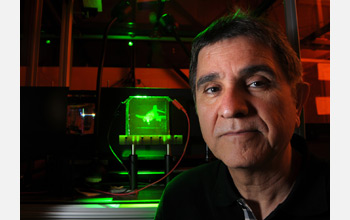All Images
News Release 10-207
The Emergence of Holographic Video
Experimental networked display refreshes holograms every two seconds
This material is available primarily for archival purposes. Telephone numbers or other contact information may be out of date; please see current contact information at media contacts.

An image of an F4 Phantom fighter jet created with the new 3D telepresence system.
Credit: University of Arizona
Download the high-resolution JPG version of the image. (965 KB)
Use your mouse to right-click (Mac users may need to Ctrl-click) the link above and choose the option that will save the file or target to your computer.
Project lead Nasser Peyghambarian of the University of Arizona, who is also director of NSF's multi-institution Engineering Research Center for Integrated Access Networks (CIAN), explains the technology--a holographic system that can transmit a series of 3D images in near-real-time, a precursor to holographic videoconferencing.
Credit: National Science Foundation
A hologram of a member of Peyghambarian's lab appears in the photorefractive polymer screen. Moving the camera from side to side reveals what the researchers call parallax, one of the novelties of this research: The holographic image presents itself from different perspectives as the viewer moves his or her head from side to side or up and down.
Credit: N. Peyghambarian, University of Arizona
This holographic representation of a vase shows different colors capable with the new system and an effect known as parallax, which makes the image life-like: As the viewer moves his or her head from side to side or up and down, the holographic image presents itself from different perspectives.
Credit: N. Peyghambarian, University of Arizona
A pulsed 50-Hz Laser inscribes a holographic image of a F-4 fighter jet into the photo-refractive polymer screen.
Credit: N. Peyghambarian, University of Arizona
A laser inscribes a series of holograms into the photorefractive polymer screen. Each iteration of the writing process takes only two seconds.
Credit: N. Peyghambarian, University of Arizona

Study co-author and project lead Nasser Peyghambarian of the University of Arizona, Tucson, the director of NSF's multi-institution Engineering Research Center for Integrated Access Networks (CIAN).
Credit: University of Arizona
Download the high-resolution JPG version of the image. (748 KB)
Use your mouse to right-click (Mac users may need to Ctrl-click) the link above and choose the option that will save the file or target to your computer.

Team member Vivian Sieh holds up the photorefractive polymer that has enabled the new 3D telepresence system to achieve a two-second refresh rate.
Credit: University of Arizona
Download the high-resolution JPG version of the image. (158 KB)
Use your mouse to right-click (Mac users may need to Ctrl-click) the link above and choose the option that will save the file or target to your computer.

The cover of the Nov. 4, 2010, issue of Nature. Not for distribution; contact press@nature.com for image usage permission.
Credit: Nature
Download the high-resolution JPG version of the image. (2 MB)
Use your mouse to right-click (Mac users may need to Ctrl-click) the link above and choose the option that will save the file or target to your computer.


